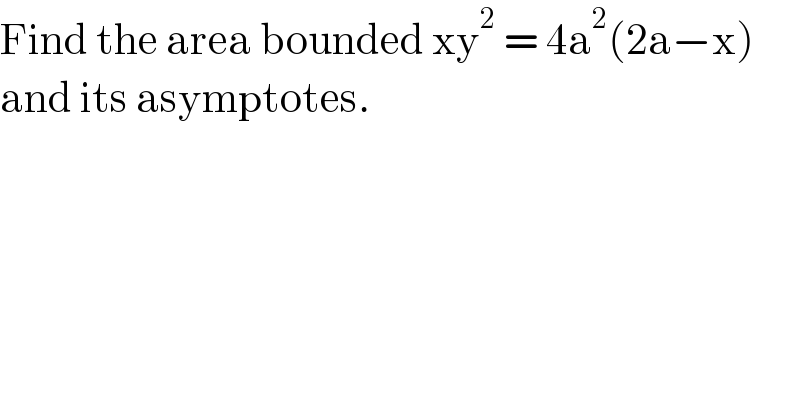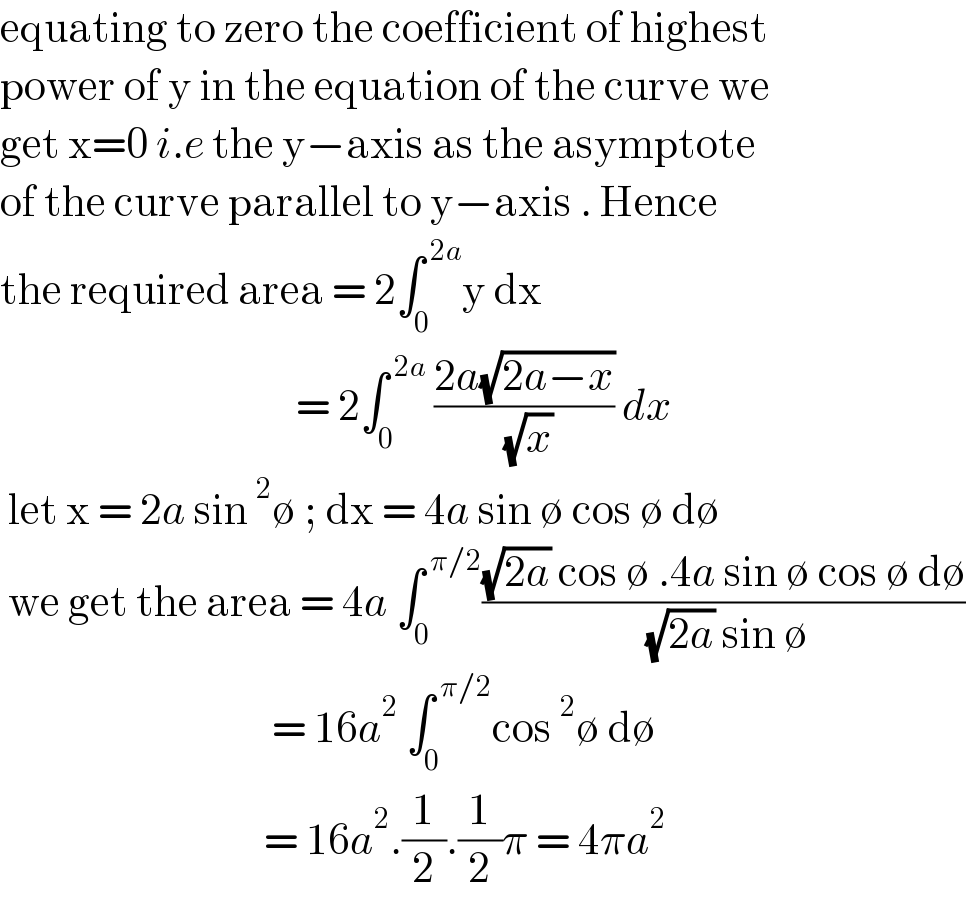
Question Number 129989 by liberty last updated on 21/Jan/21

$$\mathrm{Find}\:\mathrm{the}\:\mathrm{area}\:\mathrm{bounded}\:\mathrm{xy}^{\mathrm{2}} \:=\:\mathrm{4a}^{\mathrm{2}} \left(\mathrm{2a}−\mathrm{x}\right) \\ $$$$\mathrm{and}\:\mathrm{its}\:\mathrm{asymptotes}. \\ $$
Answered by EDWIN88 last updated on 21/Jan/21

$$\mathrm{equating}\:\mathrm{to}\:\mathrm{zero}\:\mathrm{the}\:\mathrm{coefficient}\:\mathrm{of}\:\mathrm{highest} \\ $$$$\mathrm{power}\:\mathrm{of}\:\mathrm{y}\:\mathrm{in}\:\mathrm{the}\:\mathrm{equation}\:\mathrm{of}\:\mathrm{the}\:\mathrm{curve}\:\mathrm{we} \\ $$$$\mathrm{get}\:\mathrm{x}=\mathrm{0}\:{i}.{e}\:\mathrm{the}\:\mathrm{y}−\mathrm{axis}\:\mathrm{as}\:\mathrm{the}\:\mathrm{asymptote} \\ $$$$\mathrm{of}\:\mathrm{the}\:\mathrm{curve}\:\mathrm{parallel}\:\mathrm{to}\:\mathrm{y}−\mathrm{axis}\:.\:\mathrm{Hence} \\ $$$$\mathrm{the}\:\mathrm{required}\:\mathrm{area}\:=\:\mathrm{2}\int_{\mathrm{0}} ^{\:\mathrm{2}{a}} \mathrm{y}\:\mathrm{dx}\: \\ $$$$\:\:\:\:\:\:\:\:\:\:\:\:\:\:\:\:\:\:\:\:\:\:\:\:\:\:\:\:\:\:\:\:\:\:\:\:\:=\:\mathrm{2}\int_{\mathrm{0}} ^{\:\mathrm{2}{a}} \:\frac{\mathrm{2}{a}\sqrt{\mathrm{2}{a}−{x}}}{\:\sqrt{{x}}}\:{dx}\: \\ $$$$\:\mathrm{let}\:\mathrm{x}\:=\:\mathrm{2}{a}\:\mathrm{sin}\:^{\mathrm{2}} \emptyset\:;\:\mathrm{dx}\:=\:\mathrm{4}{a}\:\mathrm{sin}\:\emptyset\:\mathrm{cos}\:\emptyset\:\mathrm{d}\emptyset \\ $$$$\:\mathrm{we}\:\mathrm{get}\:\mathrm{the}\:\mathrm{area}\:=\:\mathrm{4}{a}\:\int_{\mathrm{0}} ^{\:\pi/\mathrm{2}} \frac{\sqrt{\mathrm{2}{a}}\:\mathrm{cos}\:\emptyset\:.\mathrm{4}{a}\:\mathrm{sin}\:\emptyset\:\mathrm{cos}\:\emptyset\:\mathrm{d}\emptyset}{\:\sqrt{\mathrm{2}{a}}\:\mathrm{sin}\:\emptyset} \\ $$$$\:\:\:\:\:\:\:\:\:\:\:\:\:\:\:\:\:\:\:\:\:\:\:\:\:\:\:\:\:\:\:\:\:\:=\:\mathrm{16}{a}^{\mathrm{2}} \:\int_{\mathrm{0}} ^{\:\pi/\mathrm{2}} \mathrm{cos}\:^{\mathrm{2}} \emptyset\:\mathrm{d}\emptyset \\ $$$$\:\:\:\:\:\:\:\:\:\:\:\:\:\:\:\:\:\:\:\:\:\:\:\:\:\:\:\:\:\:\:\:\:=\:\mathrm{16}{a}^{\mathrm{2}} .\frac{\mathrm{1}}{\mathrm{2}}.\frac{\mathrm{1}}{\mathrm{2}}\pi\:=\:\mathrm{4}\pi{a}^{\mathrm{2}} \: \\ $$
